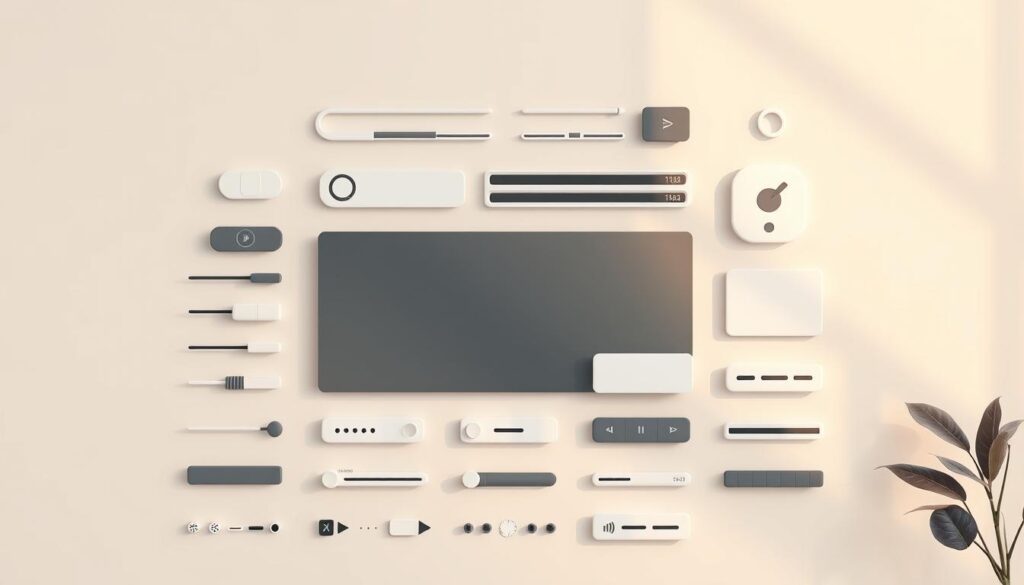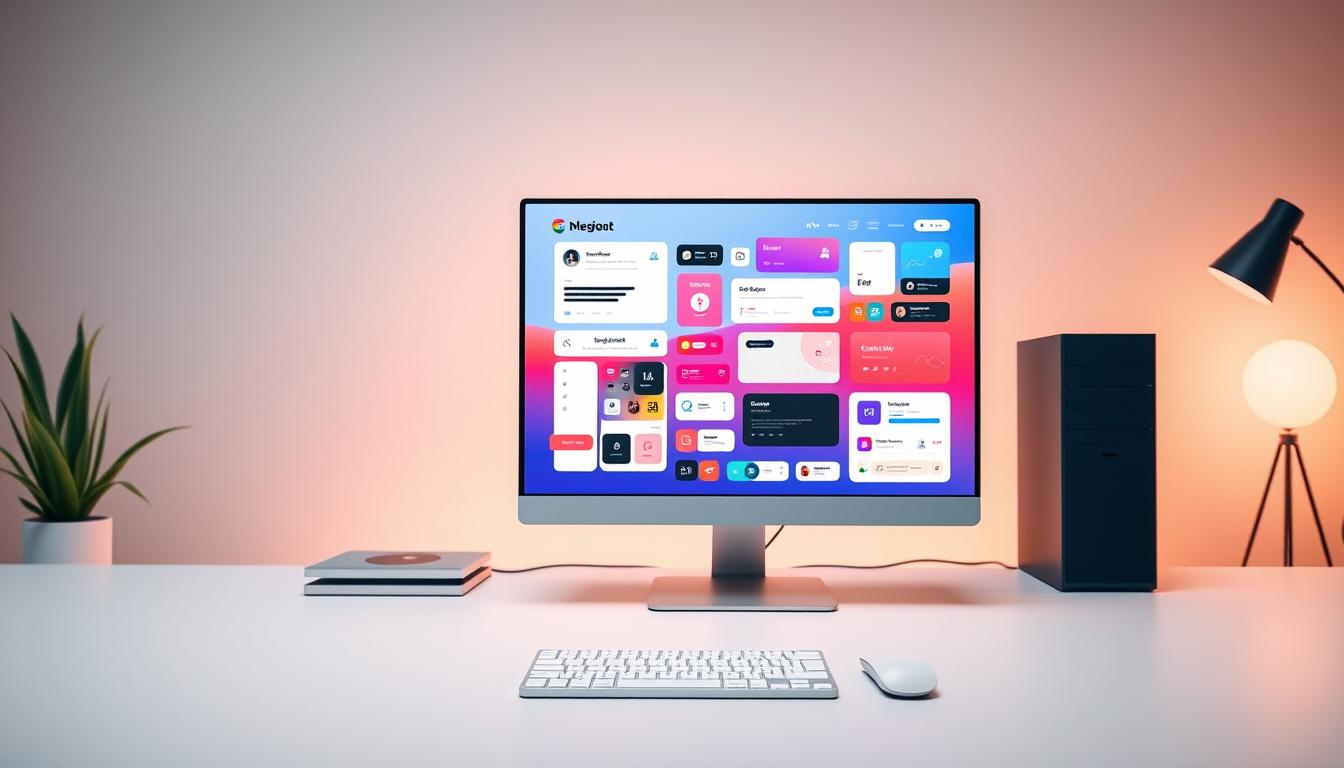In the realm of digital design, a well-crafted UI kit is indispensable for creating visually appealing and user-friendly interfaces. It serves as a foundational tool for designers, ensuring consistency and efficiency in the design process.
Designing a captivating UI kit requires a deep understanding of user interface principles and a keen eye for detail. This guide will walk you through the process of creating a comprehensive UI kit, from the initial stages of planning to the final touches of refinement.
By following this step-by-step guide, you’ll be equipped with the knowledge and skills necessary to craft a UI kit that elevates your design projects. Whether you’re a seasoned designer or just starting out, this tutorial is designed to help you achieve your design goals.
Key Takeaways
- Understand the importance of a well-designed UI kit in digital design.
- Learn the steps involved in crafting a comprehensive UI kit.
- Discover tips for ensuring consistency and efficiency in your design process.
- Gain insights into creating a visually appealing and user-friendly interface.
- Apply the knowledge to elevate your design projects.
Understanding UI Kits and Their Importance
In the realm of user interface design, UI kits play a crucial role in streamlining the design process. By providing pre-designed elements, UI kits enable designers to create consistent and engaging interfaces efficiently.
What Is a UI Kit and Why It Matters
A UI kit is a collection of pre-designed user interface elements, such as buttons, forms, and navigation bars, that are used to create a cohesive and visually appealing interface. It matters because it ensures consistency across a product, enhancing the user experience by providing a familiar and intuitive interaction.
UI kits are essential for designing ui elements that are both aesthetically pleasing and functional. By standardizing these elements, designers can focus on other aspects of the product, such as user experience and usability.
Benefits of Well-Designed UI Kits
Well-designed UI kits offer several benefits, including improved design efficiency, enhanced user experience, and faster development times. By using a UI kit, designers can avoid redundant design work and focus on creating a more cohesive and engaging user interface.
The benefits of well-designed UI kits can be summarized in the following table:
| Benefit | Description | Impact |
|---|---|---|
| Improved Design Efficiency | Standardized design elements reduce design time | Faster time-to-market |
| Enhanced User Experience | Consistent design elements improve usability | Increased user satisfaction |
| Faster Development Times | Pre-designed elements speed up development | Reduced development costs |
By adopting best ui kit practices, designers and developers can create high-quality digital products that meet user needs and expectations.

Planning Your UI Kit Project
Before diving into the design process, it’s essential to plan your UI kit project meticulously. A well-planned UI kit is the backbone of any successful digital product, providing a consistent and cohesive user experience.
Defining Your UI Kit’s Purpose and Scope
Defining the purpose and scope of your UI kit is crucial. It involves identifying the target audience, understanding the product’s goals, and determining the kit’s functionality. This step ensures that your UI kit is tailored to meet specific needs, making it more effective.
Researching Design Trends and User Needs
Researching current design trends and user needs is vital when building a UI kit from scratch. This involves analyzing competitors, understanding user behavior, and staying updated with the latest design trends to create a UI kit that is both relevant and user-friendly.
Selecting the Right Tools and Software
Choosing the right tools and software is a critical step in ui kit development tips. Popular design tools like Sketch, Figma, and Adobe XD offer various features that can streamline the design process. Selecting the most appropriate tool depends on your project’s specific needs and your team’s expertise.
By carefully planning your UI kit project, you can ensure that it meets its intended objectives and provides a solid foundation for your digital product’s success.
How to Create UI Kits: The Core Design Process
The core design process of a UI kit encompasses a range of crucial elements, from visual style to component organization. This process is fundamental in creating a UI kit that is not only aesthetically pleasing but also highly functional and consistent across different applications.
Establishing Your Visual Style and Design Language
Establishing a visual style and design language is the first step in creating a UI kit. This involves defining the overall aesthetic and tone of the kit, including the selection of colors, typography, and imagery. A well-defined visual style helps in designing consistent UI components that align with the brand’s identity.
To achieve this, designers should consider the brand’s guidelines and the target audience’s preferences. This stage is crucial for setting the foundation for a cohesive and recognizable UI kit.
Creating the Basic UI Elements
Once the visual style is established, the next step is to create the basic UI elements such as buttons, forms, and navigation menus. These elements should be designed with ui kit design principles in mind, ensuring they are intuitive, accessible, and consistent in their design.
Designing Complex Components and Patterns
After establishing the basic UI elements, designers can move on to creating more complex components and patterns. This includes designing elements like accordions, modals, and carousels, which require a deeper understanding of user interaction and behavior.
Complex components should be designed to be flexible and adaptable, allowing for various configurations and states. This ensures that the UI kit remains versatile and can be easily integrated into different projects.
Organizing Components for Maximum Usability
The final step in the core design process is organizing the components in a way that maximizes usability. This involves creating a logical structure and naming convention for the components, making it easy for developers to find and implement the right elements.
A well-organized UI kit not only enhances the designer’s workflow but also ensures that the final product is consistent and of high quality. By following these steps and adhering to ui kit design principles, designers can create a UI kit that is both functional and visually appealing.
Building Consistency and Cohesion in Your UI Kit
To create a UI kit that is both visually appealing and functional, consistency and cohesion are paramount. A well-designed UI kit ensures that all elements work together seamlessly, providing a unified user experience across different components and applications.
Creating a Unified Color System
A unified color system is the foundation of a consistent UI kit. It involves selecting a palette of colors that complement each other and using them consistently across the kit. This includes defining primary and secondary colors, as well as colors for different states such as hover, active, and disabled.
Best practices for a unified color system include limiting the color palette to 3-5 main colors and using variations of these colors for different elements. For instance, a primary blue color can be used for buttons, while a lighter shade of blue can be used for hover states.
Developing Typography Hierarchies
Typography hierarchies are crucial for creating a clear visual structure in your UI kit. This involves defining different font sizes, styles, and weights for headings, subheadings, and body text. A well-defined typography hierarchy ensures that the content is easily readable and understandable.
When developing typography hierarchies, consider the readability and legibility of the fonts. It’s also essential to limit the number of font families used to maintain consistency.
| Typography Element | Font Size | Font Weight |
|---|---|---|
| Heading 1 | 24px | Bold |
| Body Text | 14px | Regular |
| Caption | 12px | Light |
Establishing Spacing and Layout Rules
Consistent spacing and layout rules are vital for maintaining a cohesive look and feel in your UI kit. This includes defining margins, padding, and grid systems. By establishing these rules, you ensure that components are spaced consistently, making the interface more intuitive and user-friendly.
Implementing States and Interactions
States and interactions, such as hover, active, and disabled states, play a significant role in enhancing the user experience. By defining these states consistently across the UI kit, you create a more predictable and engaging interface.
When implementing states and interactions, consider the visual feedback they provide to the user. For example, a button’s hover state can change its color or background to indicate that it’s interactive.
Documentation and Implementation
Documentation and implementation are the backbone of a successful UI kit, ensuring its usability and accessibility. A well-documented UI kit facilitates efficient collaboration among designers and developers, streamlining the design-to-development handoff.
Creating Comprehensive Component Documentation
Comprehensive component documentation is vital for the effective use of a UI kit. It involves detailing the specifications, usage guidelines, and variations of each component. By doing so, designers and developers can refer to a single source of truth, reducing misunderstandings and misimplementations. Including code snippets and design files in the documentation can further enhance clarity and usability.
Versioning and Maintaining Your UI Kit
Versioning is critical for maintaining the integrity and consistency of your UI kit over time. By using version control systems, you can track changes, updates, and fixes, ensuring that all team members are working with the same version. Regular updates and maintenance are necessary to keep the UI kit aligned with the latest design trends and user needs.
Sharing and Distributing Your UI Kit
Once your UI kit is developed and documented, sharing it with the team is the next step. You can use design tools that support collaboration and versioning, such as Figma or Sketch, to distribute the UI kit. Establishing a centralized repository for the UI kit ensures that everyone has access to the latest version, promoting consistency across projects.
By focusing on thorough documentation and efficient implementation strategies, you can maximize the benefits of your UI kit, enhancing collaboration and productivity within your team.
Conclusion
Crafting a UI kit is a crucial step in creating a cohesive and engaging user experience. By following the steps outlined in this guide, designers can create UI kits that are both visually appealing and functional. The key to designing consistent UI components lies in understanding the principles of UI kit design and applying them effectively.
To create effective UI kits, it’s essential to establish a unified visual style, develop a robust design language, and maintain consistency across all components. By doing so, designers can ensure a seamless user experience across different platforms and devices. As you continue to work on your UI kit design, remember to stay focused on the principles that make a UI kit truly captivating.
By mastering how to create UI kits and applying the principles of designing consistent UI components, you can elevate your design skills and create engaging user experiences that drive results. The art of crafting captivating UI kits is a continuous learning process, and with practice and dedication, you can achieve exceptional results.
